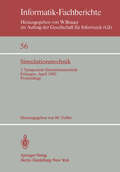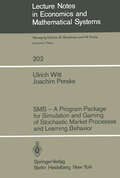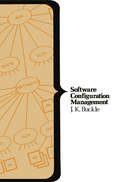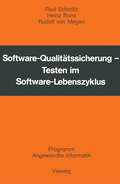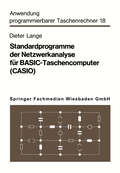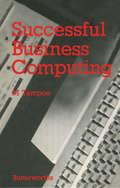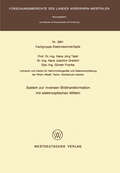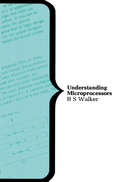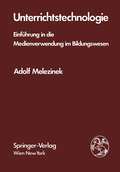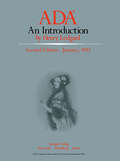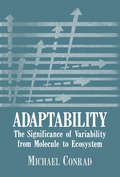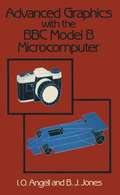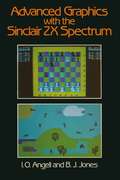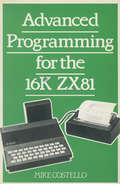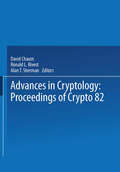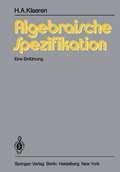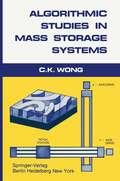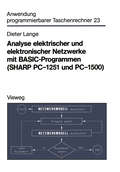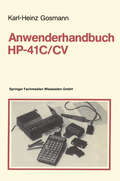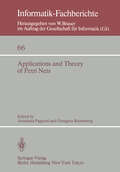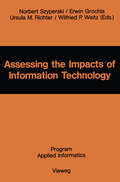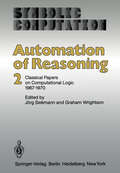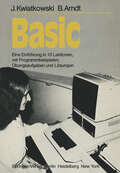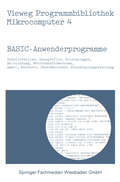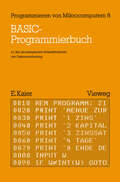- Table View
- List View
Simulationstechnik: 1. Symposium Simulationstechnik Erlangen, 26. – 28. April 1982 Proceedings (Informatik-Fachberichte #56)
by M. GollerDas erste Symposium Simulationstechnik wurde vom 26.- 28.April 1982 in Erlangen veranstaltet vom Lehrstuhl IV des Instituts für Math- matische Maschinen und Datenverarbeitung (IMMD) der Universität Erlangen - Nürnberg. Die 56 Beiträge des vorliegenden Bandes enthalten die Hauptvorträge, die Beschreibung der beim Symposium verfügbaren Simulationsmodelle, und die Vorträge der Fachgruppen Methodologie, Modellbau, Medizin, Regelungstechnik, Technische Anwendungen, Simulationsrechner und Simulationssprachen. Ein breites Einsatzgebiet der Simulation wird damit erfasst, wenn gleich es auf der ersten Veranstaltung dieser Art in Deutschland noch nicht zu erwarten war, alle Anwendungsgebiete des relativ neuen Verfahrens aufzeigen zu können. Ich möchte allen danken, die dieses Symposium besucht und erfolgreich gestaltet haben. Den Vortragenden danke ich für die Beiträge und ihre Zusammenarbeit im Hinblick auf diesen Bericht über das Symposium. Den Mitarbeitern des Lehrstuhls IV, besonders Frau E. Roth und Herrn R. Rimane danke ich für die große Hilfe bei der Organisation der Veranstaltung. Dem Springer-Verlag danke ich für die freundliche Unterstützug bei der Erstellung des Tagungsbandes. Erlangen, im Juli 1982 Manuel Goller INHALTSVERZEICHNIS EINLEITUNG Das 1. Symposium Simulationstechnik B. Schmidt ................................. .
SMS — A Program Package for Simulation and Gaming of Stochastic Market Processes and Learning Behavior (Lecture Notes in Economics and Mathematical Systems #202)
by U. Witt J. PerskeSoftware-Qualitätssicherung: Testen im Software-Lebenszyklus (Programm Angewandte Informatik)
by Paul SchmitzWenn Fehler in Software-Produkten während des Betriebs auftreten, ist dies nicht aus schließlich darauf zurückzuführen, daß in der Entwicklung zu wenig getestet worden ist. Durch verschiedene Umfragen konnten Anteile des Testaufwands (einschlißlich Pilottest) am Gesamtaufwand der Software-Entwicklung von bis zu 70 % ermittelt werden (siehe Abb. 0-1). Durchschnittlich kann man davon ausgehen daß zwischen 30 % und 50 % des Gesamtaufwands der Software-Entwicklung für Testen aufgewendet werden. Umfrage Testaufwand (U1) 20-30 % bzw. 20-40 % (U2) 60-70% inklusive Pilottest (U3) o 30-50 % für Anwendungssoftware o 30-40 % für Systemsoftware Abb. 0-1: Aufwand des Testens als Anteil des gesamten Entwicklungsaufwands /BONS82c/ Ul: /SCHM78/; U2: /SCHM80a/; U3: /SCHM8l/ Sofern der Aufwand für Testen nicht zu gering ist, sondern vielfach als zu hoch bezeichnet wird, ergibt sich zwangsläufig die Frage nach den Ursachen für die dennoch häufig be mängelte Qualität von Software-Produkten. Ursachen sind vielfach, daß zwar eine Viel zahl von Tests durchgeführt werden, jedoch überwiegend zum falschen Zeitpunkt und mit der falschen Vorgehensweise. Vorhandene Fehler werden zu spät gefunden, d. h. später als eigentlich möglich, wodurch zwangsläufig Folgefehler in den Entwicklungsschritten entstehen. Darüber hinaus werden teilweise Methoden verwendet, die nicht effizient sind. So werden z. B. für den Abnahmetest über einen bestimmten Zeitraum ausschließlich Parallelläufe durchgeführt, wobei von vornherein sicher ist, daß eine Vielzahl von Normal fällen verarbeitet werden, aber die - immer wieder zu Fehlverhalten führenden - Grenz werte oder Falschwerte nicht systematisch einbezogen werden.
Standardprogramme der Netzwerkanalyse für BASIC-Taschencomputer (Anwendung programmierbarer Taschenrechner #18)
by Dieter LangeSuccessful Business Computing
by M. TampoeSuccessful Business Computing offers a practical guide to the selection and use of a computer system. It helps identify those factors that need to be assessed in buying computer equipment and the associated computing instructions, called computer programs or software. It is a management manual and not a technical treatise on computing theory, or advanced computing. The book is organized into three main parts. Part 1 helps the reader to recognize the symptoms and assess needs. It identifies some of the reasons which prompt the purchase of computer systems and the areas of the organization which can benefit. It explains a method of pinpointing the specific application areas. It emphasizes the need for a computing policy within the organization; specifies some significant policy issues; and identifies sources of external help. Part 2 guides the reader through the buying cycle, identifying the major activities and providing guidelines for the evaluation of the systems proposed. Part 3 explains the constituents of a computer system and provides a glossary of terms. This book is intended for the businessman or executive looking for guidelines on how best to handle the task of acquiring a computer system. It can also provide students with an introduction to the application of computers and computer systems in business and commerce.
System zur inversen Bildtransformation mit elektrooptischen Mitteln (Forschungsberichte des Landes Nordrhein-Westfalen #3091)
by Hans Jörg TafelADA®: An Introduction
by Henry LedgardIf Charles Babbage is to be regarded as the father of modern day computer technology, then surely the Countess Augusta Ada Lovelace, after whom this new language is named, must be remembered as its midwife. It was she, the daughter of England's poet Lord Byron, who translated the work of the Italian mathematician L.F. Menabrea, attaching her own scientific commentaries on the dissimilarities between the difference engine and the analytical engine. It was Lady Lovelace, the great lady of computers, who delivered the notes and loosely organized writings of Babbage, with her own invaluable amendments, to a world not quite ready to receive them. The Ada language effort has employed hundreds, if not thousands, of minds and a healthy sum of money since its conception. Ada was fostered by the High Order Language Working Group (HOLWG), chartered by the U.S. Department of Defense in January of 1975 with the overall objective of developing a systematic approach to improved use of software by the military. One would think the Pentagon an unlikely foster parent for a new computer language. Regardless of its lineage, the question that begs asking is, of course - Why? The answer is by no means a simple one, but some brief background may help to clarify the matter. At present, the Department of Defense is the largest software consumer on earth, employing roughly 400 different computer languages and dialects. The situation, some have commented, is at best untidy.
Advances in Cryptology: Proceedings of Crypto 82 (Lecture Notes In Computer Science Ser. #304)
by David ChaumAlgorithmic Studies in Mass Storage Systems
by C.K. WongA major technological trend for large database systems has been the introduction of ever-larger mass storage systems. This allows computing centers and business data processing installations to maintain on line their program libraries, less frequently used data files, transaction logs and backup copies under unified system control. Tapes, disks and drums are classical examples of mass storage media. The more recent IBM 3851 Mass Storage Facility, part of the IBM 3850 Mass Storage System, represents a new direction in mass storage development, namely, it is two-dimensional. With the maturity of magnetic bubble technology, more sophisticated, massive, multi-trillion-bit storage systems are not far in the future. While large in capacity, mass storage systems have in general relatively long access times. Since record access probabilities are usually not uniform, various algorithms have been devised to position the records to decrease the average access time. The first two chapters of this book are devoted mainly to such algorithmic studies in linear and two-dimensional mass storage systems. In the third chapter, we view the bubble memory as more than a storage medium. In fact, we discuss different structures where routine operations, such as data rearrangement, sorting, searching, etc., can be done in the memory itself, freeing the CPU for more complicated tasks. The problems discussed in this book are combinatorial in nature.
Analyse elektrischer und elektronischer Netzwerke mit BASIC-Programmen (Anwendung programmierbarer Taschenrechner)
by Dieter LangeApplications and Theory of Petri Nets: Selected Papers from the 3rd European Workshop on Applications and Theory of Petri Nets Varenna, Italy, September 27–30, 1982 (under auspices of AFCET, AICA, GI, and EATCS) (Informatik-Fachberichte #66)
by A. Pagnoni G. RozenbergThis volume presents a selection of papers presented at the 3rd European Workshop on Appl ications and Theory of Petri Nets that took place in Villa Monastero, Varenna (Italy) in the period September 27 - September 30, 1982. The I ist of topics included: nets and related models, mathematical analysis of nets, transformations and morphisms of nets, formal languages and nets, parallel program verification and nets, the pro blem of time in nets, programming languages based on nets, applications to distributed systems, applications to realtime systems, software ~~gineering, hardware design and its implementation, recoverability problems, nets and formal semantics; net tools. The diversity of topics on this list witnesses the fact that the researchers from very different areas presented their contributions and discussed various research problems during the workshop. This interaction of scientists looking at the area of Petri nets from very different points of view makes this series of workshops interesting and worthwi le. The volume documents the progress of the research concerning Petri nets during a one year time from the 2nd European Workshop held in Bad Honnef in 1981. We think that this was a substantial progress indeed. This observation is even more pleasant if one real izes that during the workshop in Varenna we have celebrated 20 years of "existence" of Petri nets (the seminal work by prof. C.A. Petri appeared precisely 20 years ago). We are very proud to present an invited address by prof. C.A. Petri in this volume.
Assessing the Impacts of Information Technology: Hope to escape the negative effects of an Information Society by Research (Program applied informatics)
by Norbert SzyperskiAutomation of Reasoning: 2: Classical Papers on Computational Logic 1967–1970 (Symbolic Computation)
by J. Siekmann G. Wrightson"Kind of crude, but it works, boy, it works!" AZan NeweZZ to Herb Simon, Christmas 1955 In 1954 a computer program produced what appears to be the first computer generated mathematical proof: Written by M. Davis at the Institute of Advanced Studies, USA, it proved a number theoretic theorem in Presburger Arithmetic. Christmas 1955 heralded a computer program which generated the first proofs of some propositions of Principia Mathematica, developed by A. Newell, J. Shaw, and H. Simon at RAND Corporation, USA. In Sweden, H. Prawitz, D. Prawitz, and N. Voghera produced the first general program for the full first order predicate calculus to prove mathematical theorems; their computer proofs were obtained around 1957 and 1958, about the same time that H. Gelernter finished a computer program to prove simple high school geometry theorems. Since the field of computational logic (or automated theorem proving) is emerging from the ivory tower of academic research into real world applications, asserting also a definite place in many university curricula, we feel the time has corne to examine and evaluate its history. The article by Martin Davis in the first of this series of volumes traces the most influential ideas back to the 'prehistory' of early logical thought showing how these ideas influenced the underlying concepts of most early automatic theorem proving programs.
Basic: Eine Einführung in 10 Lektionen mit zahlreichen Programmbeispielen, 95 Übungsaufgaben und deren vollständigen Lösungen (Informationstechnik und Datenverarbeitung)
by J. Kwiatkowski B. ArndtBASIC-Anwenderprogramme (Vieweg-Programmbibliothek Mikrocomputer #4)
by Peter Frahm Werner Hürlimann Helmut Richter Harald Schumny Achim Stößer Wilfried WendtEinführung Von wichtigen internationalen Normungsorganisationen sind Bemühungen bekannt, einen einheitlichen, höheren BASIC-Dialekt zu entwickeln. Nach Verabschiedung solch eines Standards und weltweiter Akzeptierung wäre es erheblich einfacher als heute, BASIC-Programme zwischen Benutzern verschiedener Rechner aus zutauschen. Allerdings können Programme, die den Sprachenumfang des neuen Standards nutzen, nicht auf Systeme übertragen werden, die mit derzeitigen Quasi-Standardversionen arbeiten (wie z.B. Apple-, CBM- oder Tandy-BASIC) . Denn nur wenige Hersteller bieten schon jetzt erweiterte Dialekte, die etwa den Vorstellungen genügen, wie sie beispielsweise vom ANSI (American National Standards Institute) entwickelt wurden. Am ehesten entspricht schon das von Hewlett-Packard für die 80er Systeme entwickelte "Erweitere BASIC" den neuen Festlegungen wie z.B. CALL "Unterprogrammname" Aufruf eines Unterprogramms mit seinem Namen, IF •.. THEN ... ELSE ... zweiseitige Programm verzweigung, PRINT USING ... formatierte Ausgabe. Drei weitere Anweisungsgruppen zeichnen die Programmiersprache BASIC der Systeme wie HP-85 aus: - Graphik-Anweisungen zur Ausgabe von Meß- oder Berechnungs ergebnissen und Beschriftung von Diagrammen, z.B. SCALE, XAXIS, YAXIS, PLOT, DRAW, MOVE, LABEL, PEN - Befehle zur Behandlung von Hardware- und Software Interrupts, z.B. ON ERROR •.• GOSUB (oder GOTO) ON INTR ... ON KEY ..• Einführung ON TIMER •.• - Befehle zur Bedienung des IEC-Busses, z.B. ENTER, OUTPUT, .•• USING ... , Im Beitrag von w. Wendt und H. Schumny werden diese Möglich keiten weitgehend genutzt. Die konkrete Anwendung aus der nuklear-physikalischen Praxis kann sozusagen als Demonstration dafür angesehen werden, was künftige BASIC-Versionen erlauben.
